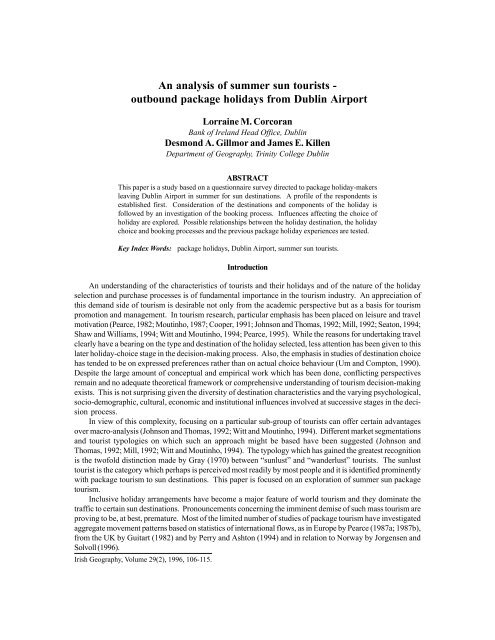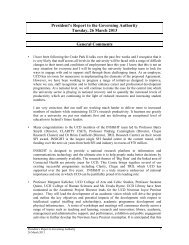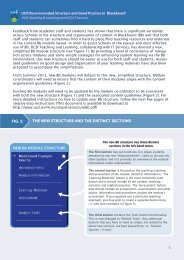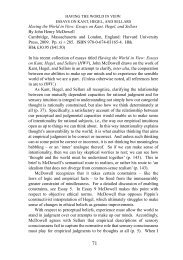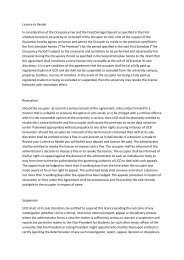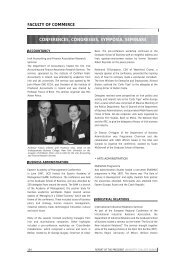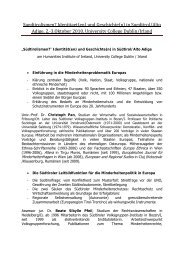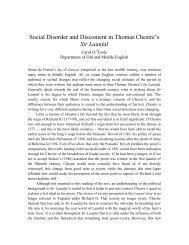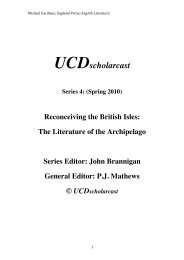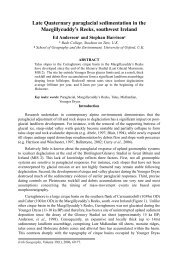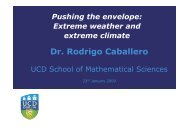An analysis of summer sun tourists - outbound package holidays ...
An analysis of summer sun tourists - outbound package holidays ...
An analysis of summer sun tourists - outbound package holidays ...
You also want an ePaper? Increase the reach of your titles
YUMPU automatically turns print PDFs into web optimized ePapers that Google loves.
106 Corcoran, Gillmor and Killen<br />
<strong>An</strong> <strong>analysis</strong> <strong>of</strong> <strong>summer</strong> <strong>sun</strong> <strong>tourists</strong> -<br />
<strong>outbound</strong> <strong>package</strong> <strong>holidays</strong> from Dublin Airport<br />
Lorraine M. Corcoran<br />
Bank <strong>of</strong> Ireland Head Office, Dublin<br />
Desmond A. Gillmor and James E. Killen<br />
Department <strong>of</strong> Geography, Trinity College Dublin<br />
ABSTRACT<br />
This paper is a study based on a questionnaire survey directed to <strong>package</strong> holiday-makers<br />
leaving Dublin Airport in <strong>summer</strong> for <strong>sun</strong> destinations. A pr<strong>of</strong>ile <strong>of</strong> the respondents is<br />
established first. Consideration <strong>of</strong> the destinations and components <strong>of</strong> the holiday is<br />
followed by an investigation <strong>of</strong> the booking process. Influences affecting the choice <strong>of</strong><br />
holiday are explored. Possible relationships between the holiday destination, the holiday<br />
choice and booking processes and the previous <strong>package</strong> holiday experiences are tested.<br />
Key Index Words: <strong>package</strong> <strong>holidays</strong>, Dublin Airport, <strong>summer</strong> <strong>sun</strong> <strong>tourists</strong>.<br />
Introduction<br />
<strong>An</strong> understanding <strong>of</strong> the characteristics <strong>of</strong> <strong>tourists</strong> and their <strong>holidays</strong> and <strong>of</strong> the nature <strong>of</strong> the holiday<br />
selection and purchase processes is <strong>of</strong> fundamental importance in the tourism industry. <strong>An</strong> appreciation <strong>of</strong><br />
this demand side <strong>of</strong> tourism is desirable not only from the academic perspective but as a basis for tourism<br />
promotion and management. In tourism research, particular emphasis has been placed on leisure and travel<br />
motivation (Pearce, 1982; Moutinho, 1987; Cooper, 1991; Johnson and Thomas, 1992; Mill, 1992; Seaton, 1994;<br />
Shaw and Williams, 1994; Witt and Moutinho, 1994; Pearce, 1995). While the reasons for undertaking travel<br />
clearly have a bearing on the type and destination <strong>of</strong> the holiday selected, less attention has been given to this<br />
later holiday-choice stage in the decision-making process. Also, the emphasis in studies <strong>of</strong> destination choice<br />
has tended to be on expressed preferences rather than on actual choice behaviour (Um and Compton, 1990).<br />
Despite the large amount <strong>of</strong> conceptual and empirical work which has been done, conflicting perspectives<br />
remain and no adequate theoretical framework or comprehensive understanding <strong>of</strong> tourism decision-making<br />
exists. This is not surprising given the diversity <strong>of</strong> destination characteristics and the varying psychological,<br />
socio-demographic, cultural, economic and institutional influences involved at successive stages in the decision<br />
process.<br />
In view <strong>of</strong> this complexity, focusing on a particular sub-group <strong>of</strong> <strong>tourists</strong> can <strong>of</strong>fer certain advantages<br />
over macro-<strong>analysis</strong> (Johnson and Thomas, 1992; Witt and Moutinho, 1994). Different market segmentations<br />
and tourist typologies on which such an approach might be based have been suggested (Johnson and<br />
Thomas, 1992; Mill, 1992; Witt and Moutinho, 1994). The typology which has gained the greatest recognition<br />
is the tw<strong>of</strong>old distinction made by Gray (1970) between “<strong>sun</strong>lust” and “wanderlust” <strong>tourists</strong>. The <strong>sun</strong>lust<br />
tourist is the category which perhaps is perceived most readily by most people and it is identified prominently<br />
with <strong>package</strong> tourism to <strong>sun</strong> destinations. This paper is focused on an exploration <strong>of</strong> <strong>summer</strong> <strong>sun</strong> <strong>package</strong><br />
tourism.<br />
Inclusive holiday arrangements have become a major feature <strong>of</strong> world tourism and they dominate the<br />
traffic to certain <strong>sun</strong> destinations. Pronouncements concerning the imminent demise <strong>of</strong> such mass tourism are<br />
proving to be, at best, premature. Most <strong>of</strong> the limited number <strong>of</strong> studies <strong>of</strong> <strong>package</strong> tourism have investigated<br />
aggregate movement patterns based on statistics <strong>of</strong> international flows, as in Europe by Pearce (1987a; 1987b),<br />
from the UK by Guitart (1982) and by Perry and Ashton (1994) and in relation to Norway by Jorgensen and<br />
Solvoll (1996).<br />
Irish Geography, Volume 29(2), 1996, 106-115.
Summer Sun Tourism 107<br />
Given the huge importance <strong>of</strong> the sector, it is surprising that the literature contains so little research at the<br />
level <strong>of</strong> the individual <strong>package</strong> tourist. Tour operators undertake or commission varying amounts <strong>of</strong> market<br />
research but the findings are commercially sensitive and are not published. Thomson and Pearce (1980)<br />
compared the pr<strong>of</strong>iles and tour selections <strong>of</strong> coach, camping and fly-drive <strong>package</strong> <strong>tourists</strong> in New Zealand.<br />
Quiroga (1990) investigated aspects <strong>of</strong> <strong>package</strong> tourist pr<strong>of</strong>ile and motivation with specific reference to Latin<br />
American participants on coach tours <strong>of</strong> Europe but the main focus <strong>of</strong> the work was on group dynamics.<br />
One-third <strong>of</strong> overseas <strong>holidays</strong> taken by residents <strong>of</strong> the Republic <strong>of</strong> Ireland are on a fully inclusive<br />
<strong>package</strong> arrangement (Bord Fáilte, 1995). With the patterns <strong>of</strong> air charter tourism from Ireland having been<br />
determined already (Gillmor, 1973; 1996), the next stage in research was to investigate at the level <strong>of</strong> the<br />
individual <strong>package</strong> tourist. The present study was undertaken with the objective <strong>of</strong> exploring certain questions<br />
directly with these <strong>tourists</strong>. What types <strong>of</strong> individual go on <strong>package</strong> <strong>holidays</strong> and why is this type <strong>of</strong><br />
holiday preferred? How is the destination <strong>of</strong> the holiday chosen and to what extent does the travel trade<br />
influence this decision? Do variables such as socio-economic status and past travel experience have a<br />
bearing on the holiday decision? Apart from their intrinsic academic interest, responses to these types <strong>of</strong><br />
question should be <strong>of</strong> value to the travel trade which seeks to provide saleable holiday products and to<br />
promote them in ways to attract customers. Greater understanding <strong>of</strong> clients by the industry is ultimately in<br />
the consumers’ interest also. The findings <strong>of</strong> the survey are <strong>of</strong> relevance not only in the Irish context but also<br />
internationally because studies have demonstrated a certain uniformity in tourist practice from country to<br />
country and over time (Krippendorf, 1987).<br />
The Survey<br />
A study <strong>of</strong> <strong>tourists</strong> going on <strong>package</strong> <strong>holidays</strong> to <strong>sun</strong> destinations advertised as commencing in Dublin<br />
in <strong>summer</strong> 1993 is described in this paper. A <strong>package</strong> holiday was taken to include, at a minimum, return flights<br />
between Dublin and the holiday destination by chartered or scheduled aircraft and accommodation. The<br />
questionnaire survey on which the study is based sought information concerning: respondent characteristics;<br />
the holiday being undertaken; the booking <strong>of</strong> the holiday; the holiday choice process. From this information,<br />
a reasonably complete picture <strong>of</strong> the <strong>tourists</strong> was obtained from which it was possible to test various<br />
hypotheses concerning the types <strong>of</strong> question posed previously.<br />
The sampling procedure was designed to generate a sample representative <strong>of</strong> <strong>summer</strong> <strong>sun</strong> <strong>package</strong><br />
holiday <strong>tourists</strong> departing from Dublin Airport. Information concerning flight departures which had been<br />
obtained from brochures and other literature circulated by the tour operators was cross-checked against a<br />
timetable <strong>of</strong> charter flights obtained from Aer Rianta, the Irish Airports Authority. In addition, the times <strong>of</strong><br />
scheduled flights upon which it was known <strong>summer</strong> <strong>sun</strong> <strong>package</strong> holiday-makers might be travelling were<br />
noted. From this information, a list <strong>of</strong> all “target flights” was compiled and they were surveyed with reference<br />
to the numbers <strong>of</strong> holiday-makers going to the different destinations. Passengers were interviewed at random<br />
by the first author in the boarding areas <strong>of</strong> targetted flights on 26 days between 19 June and 12 September,<br />
following a pilot survey in early June. If a passenger when approached stated that s/he was not embarking on<br />
a <strong>package</strong> holiday, the interview was closed. Where a group, comprising family or friends, was encountered,<br />
the individual with the greatest knowledge about the forthcoming holiday was questioned.<br />
The number <strong>of</strong> succesful interviews with <strong>sun</strong> <strong>package</strong> <strong>tourists</strong> was 300. The non-response rate was 3.2%.<br />
This extremely low rate may reflect to some extent the fact that many <strong>of</strong> the respondents had little to do whilst<br />
waiting for their flights to board.<br />
Survey Results<br />
Respondent Characteristics<br />
Exactly half <strong>of</strong> the <strong>tourists</strong> interviewed were aged 18-29, with a further 27.3% being 30-44 years. The<br />
average size <strong>of</strong> group travelling was 3.06, with a standard deviation <strong>of</strong> 1.92. Interviewees varied from those<br />
travelling alone to one with sixteen friends. Females constituted 63.7% <strong>of</strong> the survey sample. The distribution<br />
<strong>of</strong> reported annual earnings is shown in Table 1. The income recorded was gross family income or, in the
108 Corcoran, Gillmor and Killen<br />
case <strong>of</strong> those who were financially independent, gross personal income. That the income available to them for<br />
<strong>holidays</strong> had increased over the last five years was reported by 55.7% <strong>of</strong> respondents while 29.0% estimated<br />
that it had stayed the same. The essentially middle class character <strong>of</strong> the respondents is underlined by the<br />
occupations reported; 25.3% <strong>of</strong> the sample described themselves as pr<strong>of</strong>essionals or managers and a further<br />
48.0% were in a range <strong>of</strong> other non-manual occupations. In contrast, just 11.3% <strong>of</strong> the sample were manual<br />
workers. Those who described themselves as housewives constituted 10.0% <strong>of</strong> the sample, while 2.0% were<br />
students and 1.7% had retired.<br />
Table 1: Distribution <strong>of</strong> reported annual earnings.<br />
Income IR£<br />
Percentage <strong>of</strong> Sample<br />
40,000 7.0%<br />
No Response 5.3%<br />
With regard to place <strong>of</strong> residence within Ireland, 64.7% <strong>of</strong> the respondents were from Leinster, 13.7% from<br />
Ulster (including 11.3% from Northern Ireland), 16.3% from Munster and 5.3% from Connacht. The dominance<br />
<strong>of</strong> Leinster results from its accessibility to Dublin Airport and the importance <strong>of</strong> the Dublin market in particular.<br />
Conversely, the extent to which Dublin Airport draws from the other provinces, despite their access to other<br />
airports with <strong>summer</strong> <strong>sun</strong> <strong>package</strong> departures (Belfast, Cork and Shannon), reflects the fact that by far the<br />
greatest number and variety <strong>of</strong> such <strong>package</strong>s are <strong>of</strong>fered out <strong>of</strong> Dublin; Dublin Airport accounts for about<br />
90% <strong>of</strong> all <strong>outbound</strong> <strong>package</strong> travel from the Republic <strong>of</strong> Ireland (Gillmor, 1993).<br />
For the 47.3% <strong>of</strong> respondents resident in the built-up area <strong>of</strong> Dublin, their addresses could be related to<br />
the corresponding socio-economic areas <strong>of</strong> the city, as mapped by Brady (1987). Of the six levels <strong>of</strong> socioeconomic<br />
status recognised by him, 59.1% <strong>of</strong> Dublin respondents came from the second and third highest<br />
status areas as compared with 29.6% from the second and third lowest. Yet as many came from the lowest<br />
category <strong>of</strong> area as from the highest (5.6%), suggesting that at the top <strong>of</strong> the socio-economic scale, there may<br />
be a lesser tendency to use <strong>summer</strong> <strong>sun</strong> <strong>package</strong> arrangements when choosing a holiday than is the practice<br />
at the intermediate levels.<br />
Of those interviewed, 14.3% were embarking on their first <strong>package</strong> holiday <strong>of</strong> any type, while 18.4% had<br />
been on one such holiday before, 15.3% had been twice and 52.0% had been on at least three such <strong>holidays</strong>.<br />
Thus the respondents were generally very familiar with <strong>package</strong> holiday taking. A small majority (53.7%)<br />
indicated that the holiday upon which they were embarking would be or was likely to be their only holiday<br />
abroad during the year.<br />
The Holiday Being Undertaken<br />
The destinations reported by the respondents are set out in Table 2. The traditional destinations, namely<br />
mainland Spain, the Balearics, Portugal, the Canaries, Greece, Turkey and Cyprus, predominated. As expected,<br />
this mainly Mediterranean distribution reflected the structure <strong>of</strong> the Republic <strong>of</strong> Ireland’s total aircharter<br />
market in 1991, although in that year traffic to Turkey and Cyprus had been depressed by the effect <strong>of</strong><br />
the Gulf War (Gillmor, 1996). As many as 79.7% <strong>of</strong> the sample stated that they had never been to the resort to
Summer Sun Tourism 109<br />
which they were travelling, while 11.0% had been there only once before. It suggests that there is considerable<br />
fluidity at the level <strong>of</strong> the individual with regard to choice <strong>of</strong> resort. This might seem to contradict the<br />
perceived image <strong>of</strong> the <strong>package</strong> holiday-maker as being conservative and the fact that the range <strong>of</strong> destinations<br />
<strong>of</strong> Irish air-charter traffic has not changed dramatically over the years (Gillmor, 1996). The implication<br />
may be, however, that while there is a tendency to return to the same destination areas and the same types <strong>of</strong><br />
resort, individuals do not tend to return to the same resorts.<br />
The fortnight <strong>package</strong> was the standard holiday, with 80.7% <strong>of</strong> respondents embarking on a holiday <strong>of</strong><br />
two weeks duration and 14.3% staying away for one week only. The most common type <strong>of</strong> accommodation<br />
involved in the <strong>package</strong> was a self-catering apartment (63.0%) while 26.7% <strong>of</strong> respondents were staying in a<br />
hotel. Other types <strong>of</strong> accommodation mentioned included bed and breakfast establishments and guesthouses.<br />
One-third <strong>of</strong> respondents reported that their holiday had been sold with at least one extra feature.<br />
These included the provision <strong>of</strong> certain meals, free excursions, transfers to/from Dublin Airport, a hire car,<br />
sports facilities and vouchers for free drinks. The mean reported total cost <strong>of</strong> the holiday was IR£418 with a<br />
standard deviation <strong>of</strong> IR£112; the mean cost per day was IR£33.26 with a standard deviation <strong>of</strong> IR£12.65.<br />
Table 2: Number <strong>of</strong> respondents travelling to each destination.<br />
Destination Number %<br />
Canaries 47 15.7<br />
Greece 44 14.7<br />
Balearics 1 36 12.0<br />
Portugal 30 10.0<br />
Turkey 2 27 9.0<br />
Cyprus 2 20 6.7<br />
Bulgaria 3 18 6.0<br />
Florida 4 18 6.0<br />
Spain (mainland) 1 12 4.0<br />
Morocco 3 12 4.0<br />
Tunisia 3 11 3.7<br />
Malta 4 10 3.3<br />
Jersey 4 7 2.3<br />
Other destinations 4 8 2.7<br />
Total 300 100.0<br />
Note: For the purposes <strong>of</strong> hypothesis testing, destinations with the same superscript were amalgamated.<br />
Booking the Holiday<br />
Booking through a travel agent accounted for 83.7% <strong>of</strong> all <strong>holidays</strong>, while the remaining 16.3% had been<br />
booked direct with the tour operator. This underlines the importance <strong>of</strong> the travel agent as an intermediary<br />
within the <strong>package</strong> holiday industry; there are sales outlets throughout the country <strong>of</strong>fering a wide range <strong>of</strong><br />
holiday products. Yet, it is the tour operators, and especially the large ones, which determine the <strong>holidays</strong> on<br />
<strong>of</strong>fer; 73.8% <strong>of</strong> all <strong>holidays</strong> recorded in the survey were organised by the four largest operators and subsequent<br />
takeovers mean that two British-owned companies now control over 80% <strong>of</strong> the Irish air-charter <strong>summer</strong><br />
holiday market.<br />
The length <strong>of</strong> time elapsing between booking the holiday and departing ranged from seven months to one<br />
week, with a modal value <strong>of</strong> five months and a mean <strong>of</strong> 3.18 months. The data indicate that, while the majority<br />
booked a considerable period in advance, there was also a significant minority who booked just prior to<br />
departure. The results suggest that the release <strong>of</strong> brochures had a significant impact on booking patterns; the
110 Corcoran, Gillmor and Killen<br />
<strong>summer</strong> <strong>sun</strong> <strong>package</strong> holiday brochures were released on the Irish market in January and many people made<br />
their holiday decisions immediately afterwards.<br />
There were varied responses to a question asking why the holiday was booked when it was. A statement<br />
simply that the holiday was booked as soon as the decision to take it had been made was given by 58.3% <strong>of</strong><br />
respondents, generally with the objective <strong>of</strong> securing the preferred holiday. Price considerations and/or the<br />
availability <strong>of</strong> special <strong>of</strong>fers had caused 25.3% <strong>of</strong> respondents to book the holiday when they did. This<br />
suggests that these types <strong>of</strong> incentive are indeed important tools which can be used by the tour operators to<br />
secure bookings. In recent years, special <strong>of</strong>fers relating to reservations before certain dates have been made<br />
by some operators; a midnight sale by one <strong>of</strong> the biggest companies led to overloading and breakdown <strong>of</strong> its<br />
large computer system in January 1995. A pattern <strong>of</strong> always booking the holiday at the same time each year<br />
was reported by 14.0% <strong>of</strong> respondents. The time <strong>of</strong> booking depends in part on the character <strong>of</strong> the individual<br />
tourist, ranging from the “meticulous planner” who has a long horizon to the “impulse buyer” who is attracted<br />
by cut-price late availabilities (Goodall, 1988).<br />
The Holiday Choice Process<br />
For most respondents, the opportunity set from which their particular <strong>package</strong> holiday was selected<br />
would have consisted <strong>of</strong> those <strong>package</strong>s available on the Irish market and for some it would have been limited<br />
to those <strong>of</strong>fered by one or a very small number <strong>of</strong> tour operators (Stabler, 1991). On being asked the reasons<br />
why they had chosen the particular holiday upon which they were embarking, a wide range <strong>of</strong> responses was<br />
given (Table 3).<br />
Table 3: Reasons cited for choosing a particular <strong>summer</strong> <strong>sun</strong> <strong>package</strong> holiday.<br />
Reason<br />
Percentage citing this reason<br />
Respondent related<br />
Recommended 35.3<br />
Somewhere different 23.0<br />
Been before 22.0<br />
Operator related<br />
Available 23.6<br />
Price/Special <strong>of</strong>fer 11.3<br />
Brochure 9.3<br />
Destination related<br />
Facilities/Atmosphere 29.6<br />
Weather 19.6<br />
Cultural and other sights 4.0<br />
Journey related<br />
Flight time 5.0<br />
Tranfer time 1.6<br />
Other 5.0<br />
Note: Due to multiple answers being given, the percentage figures sum to in excess <strong>of</strong> 100.<br />
First, the importance <strong>of</strong> a personal recommendation, whether from friends and relatives or from a member<br />
<strong>of</strong> the travel trade can be seen. Personal preferences were obviously important too; while some respondents<br />
cited familiarity with an area as a reason for returning there, an almost equal percentage cited as a positive<br />
factor the fact that the chosen holiday was to a different area or resort. The crucial role <strong>of</strong> the tour operator can<br />
be seen in the frequency with which availability and price, including special <strong>of</strong>fers, were mentioned as being
Summer Sun Tourism 111<br />
important determinants within the overall choice process and from the fact that almost 10% <strong>of</strong> respondents<br />
cited the operator’s brochure as having had some influence on their choice. The perceived characteristics <strong>of</strong><br />
the destination in terms <strong>of</strong> its weather, facilities and atmosphere, but not to any great extent in terms <strong>of</strong> its<br />
cutural and scenic attractions, were mentioned also. Finally, the characteristics <strong>of</strong> the journey to and from the<br />
holiday destination were <strong>of</strong> relatively minor importance. This might seem to contradict the general tendency<br />
for vacation decisions to be influenced greatly by travel distance (<strong>An</strong>komah et al., 1996) but presumably it<br />
reflects the fact that the <strong>package</strong> <strong>holidays</strong> from which most respondents were selecting did not differ greatly<br />
in terms <strong>of</strong> length <strong>of</strong> journey.<br />
A conclusion arising from investigation <strong>of</strong> the selection process is that the member <strong>of</strong> the travel trade with<br />
whom the holiday was booked appeared to have had relatively little influence on the actual choice <strong>of</strong> holiday<br />
but rather acted as a source <strong>of</strong> information and perhaps <strong>of</strong>fered a general recommendation. When asked where<br />
they had heard about the resort, 31.0% indicated the travel agent, 26.3% brochures and advertising and 25.0%<br />
relatives and friends. Yet 60.3% <strong>of</strong> respondents reported that the individual with whom they booked the<br />
holiday had no influence on their decision, while only 17.3% and 8.7% <strong>of</strong> respondents stated that this person<br />
had influenced the choice <strong>of</strong> resort and the choice <strong>of</strong> accommodation respectively and a further 13.0% reported<br />
recommendation <strong>of</strong> both resort and accommodation. The booking agent acted therefore mainly as a<br />
facilitator; 66.3% <strong>of</strong> respondents reported that the individual concerned had been “very helpful” while a<br />
further 27.3% stated that this person had been “helpful”. Evidence from elsewhere suggests that the advisory<br />
role <strong>of</strong> the travel agent relative to brochures has diminished (Mansfield, 1992).<br />
In order to throw further light on the holiday choice process, respondents were asked how many other<br />
<strong>package</strong> <strong>holidays</strong> they had considered seriously but rejected before arriving at their final choice. No alternative<br />
had been considered by 56% <strong>of</strong> respondents, while 30% had considered just one alternative. The reasons<br />
for rejecting a particular initially-considered possibility included principally its non-availability but also inconvenient<br />
flight times, the receipt <strong>of</strong> bad reports concerning the intended destination and that the respondent<br />
had been there before. With regard to the third factor and underlining the impact <strong>of</strong> a negative image on the<br />
holiday choice process, media reports <strong>of</strong> adverse experiences <strong>of</strong> <strong>tourists</strong> in Jamaica in June 1993 caused two<br />
hundred Irish people to cancel their holiday there.<br />
In response to a question seeking the reasons why the respondent had booked a <strong>package</strong> holiday as<br />
distinct from a non-<strong>package</strong> holiday, 57.6% cited the convenience involved while 20.3% stated that price was<br />
an important consideration. Peace <strong>of</strong> mind and familiarity with this type <strong>of</strong> holiday were mentioned by 14.3%<br />
and 13.0% <strong>of</strong> respondents respectively. As in any such query, the role <strong>of</strong> price may have been downplayed by<br />
respondents, in part because most would have been unaware <strong>of</strong> the cost <strong>of</strong> an equivalent holiday arranged<br />
independently.<br />
Hypothesis Testing<br />
The data set from which the foregoing results were derived <strong>of</strong>fered a base which could be used to test<br />
statistically various hyptheses concerning possible relationships between the variables. Hypotheses relating<br />
to three broad areas were tested: holiday destination; the holiday choice and booking processes; past <strong>package</strong><br />
<strong>holidays</strong>.<br />
Two types <strong>of</strong> statistical test were employed: where both variables being tested were category variables,<br />
a chi-square (contingency tables) test was used; where a category and continuous variable were tested, a oneway<br />
<strong>analysis</strong> <strong>of</strong> variance was employed. In general, tests yielding a significant result at a probability level <strong>of</strong><br />
less than or equal to 0.05 were considered to merit discussion.<br />
Holiday Destination<br />
Destination, split into the seven categories indicated in Table 2, was tested against the range <strong>of</strong> socioeconomic<br />
variables listed in Table 4 using the chi-square test. Two variables, namely age and province <strong>of</strong><br />
residence yielded significant results, while that concerning income was less significant.<br />
The nature <strong>of</strong> the relationship indicated by a significant chi-square test result can be investigated by
112 Corcoran, Gillmor and Killen<br />
comparing the number <strong>of</strong> observations falling into each combination <strong>of</strong> categories with the number which<br />
would be expected to fall there if no relationship existed. In the case <strong>of</strong> destination and age, it was found that<br />
more respondents in the 18-29 age group than would be expected if no relationship were present were travelling<br />
to Greece, the Canaries and Turkey/Cyprus, while more respondents in the 30-44 age group than would be<br />
expected were travelling to mainland Spain/Balearics. More respondents in the 45+ age group than would be<br />
expected were travelling to Tunisia/Morocco/Bulgaria and to the destinations in the “other” category. Overall,<br />
the results suggest that as age increases, different resorts appeal, so that holiday choice can be linked with<br />
stage in the life cycle or travel career (Bojanic, 1992). Greece, the Canaries and Turkey/Cyprus were chosen<br />
more by the younger age groups, while mainland Spain and the Balearics tended to appeal to those age groups<br />
likely to be travelling as family groups. The oldest age group, that is those who probably have visited the<br />
established destinations already, appeared to be most willing to travel to new destinations.<br />
Table 4: Chi-square test results for destination by various socio-economic variables.<br />
Variable Number <strong>of</strong> categories Significance level<br />
Destination by 7<br />
- Age <strong>of</strong> respondent 3 .0074<br />
- Province <strong>of</strong> residence 1 4 .0002<br />
- Socio-economic status <strong>of</strong> area <strong>of</strong> residence 6 .9528<br />
- Occupational group 2 8<br />
- Income 3 .0111<br />
- Change in income available for <strong>holidays</strong> 3 .8765<br />
1 For this test, three destination groupings were used:<br />
(i) traditional Spanish-Portuguese destinations: Spain (mainland)/Balearics/Portugal/Canaries,<br />
(ii) traditional eastern Mediterranean destinations: Greece/Cyprus/Turkey,<br />
(iii) other destinations.<br />
2 The chi-square test requirement that not more than 20% <strong>of</strong> the expected cell values be less than five<br />
and that none be less than one was violated in the case <strong>of</strong> the occupational group test.<br />
Turning to province <strong>of</strong> residence, the chi-square test using the seven destination categories indicated in<br />
Table 2 was inconclusive, as more than 20% <strong>of</strong> the expected cell values were less than five. For this test<br />
therefore, the destinations were further amalgamated into the three groupings set out in the first note to Table<br />
4. More respondents than would be expected from Munster and Ulster were travelling to the traditional<br />
eastern Mediterranean destinations, while more respondents than would be expected from Leinster were<br />
travelling to “other destinations”. This suggests, albeit tentatively in view <strong>of</strong> the coarseness <strong>of</strong> the destination<br />
groupings, that there may have existed a difference in the destination choice process between urban and<br />
rural residents, with the latter preferring the more traditional destinations.<br />
With regard to income, more people on lower incomes (less than IR£15,000 per annum) than would be<br />
expected were travelling to Greece/Turkey/Cyprus, while more medium (IR£15,001-30,000 per annum) and<br />
higher (over IR£30,000 per annum) income respondents than would be expected were going to the nontraditional<br />
destinations.<br />
Taken as a whole, the foregoing results suggest that there is a definite relationship between socioeconomic<br />
status, stage in the life cycle and choice <strong>of</strong> destination for a <strong>summer</strong> <strong>sun</strong> <strong>package</strong> holiday. To some<br />
extent, this may reflect the varying prices <strong>of</strong> the <strong>holidays</strong> at the different destinations and the varying amounts
Summer Sun Tourism 113<br />
<strong>of</strong> money available to the different age groups for holiday expenditure. <strong>An</strong> <strong>analysis</strong> <strong>of</strong> variance <strong>of</strong> holiday cost<br />
per person per day by destination (seven categories) yielded a highly significant (probability
114 Corcoran, Gillmor and Killen<br />
Number <strong>of</strong> Past Package Holidays<br />
It was hypothesised that the destination <strong>of</strong> the current holiday (seven categories) might be related to the<br />
number <strong>of</strong> previous <strong>package</strong> <strong>holidays</strong> <strong>of</strong> any type undertaken (four categories). The chi-square test was<br />
significant at a probability <strong>of</strong> 0.024. More respondents than would be expected who were travelling on their<br />
first <strong>package</strong> holiday were destined for Portugal, while more who had had just one such holiday previously<br />
were going to Greece. More respondents than would be expected who had had at least three <strong>package</strong> <strong>holidays</strong><br />
were en route to the Canary Islands or to Tunisia/Bulgaria/Morocco. This result supports the earlier conclusion<br />
that initial <strong>package</strong> <strong>holidays</strong> tend to be taken to the more traditional (and <strong>of</strong>ten lower cost) destinations,<br />
while it is the more experienced <strong>package</strong> holiday-maker who tends to be attracted most readily to the newer<br />
destinations. Stage in the life cycle or travel career is also likely to play a role here with the more experienced<br />
<strong>package</strong> holiday-makers tending to have more money to spend on the holiday. The attraction <strong>of</strong> the Canaries<br />
to those who had undertaken three or more <strong>package</strong> <strong>holidays</strong> before appears to be an exception to this trend.<br />
The extent <strong>of</strong> repeat business to the Canaries reflects in part the fact that a number <strong>of</strong> respondents had been<br />
on winter holiday <strong>package</strong>s there, the winter <strong>sun</strong> market from Ireland being dominated by the Canaries.<br />
It was hypothesised also that the number <strong>of</strong> past <strong>package</strong> <strong>holidays</strong> <strong>of</strong> any type undertaken might be<br />
related to occupation (eight categories) and to income (three categories). In the light <strong>of</strong> the foregoing observations,<br />
it is perhaps disappointing that the relevant chi-square tests yielded no such evidence. This may<br />
reflect an inadequacy in the manner in which the number <strong>of</strong> past <strong>package</strong> <strong>holidays</strong> was measured; a majority<br />
<strong>of</strong> respondents (52%) had taken three or more such <strong>holidays</strong> previously but no attempt was made in the<br />
survey to disaggregate this category further.<br />
Conclusion<br />
The results <strong>of</strong> the survey reported in this paper provide useful insights into <strong>package</strong> tourism from Dublin<br />
Airport and into the sector in general. The hypothetical “average” <strong>package</strong> tourist going to a <strong>sun</strong> destination<br />
was a young, middle class, urban female who was travelling in a group <strong>of</strong> three. She had been on several<br />
previous <strong>package</strong> <strong>holidays</strong> but this was her only foreign holiday in the current year. She was going to a<br />
Mediterranean resort not previously visited. The fortnight holiday was in a self-catering apartment and cost<br />
IR£418. It was with one <strong>of</strong> the major tour operators. It had been booked through a travel agent three months<br />
previously and shortly after deciding to take the holiday. The choice <strong>of</strong> holiday was influenced mainly by<br />
informal recommendations, holiday availability and destination character. Although being a source <strong>of</strong> information<br />
and helpful, the travel agent’s advisory role was limited. The <strong>package</strong> holiday was chosen for convenience<br />
and no alternative <strong>package</strong> was considered seriously.<br />
With regard to the sample as a whole, the choice <strong>of</strong> holiday destination was related to the tourist’s age,<br />
province <strong>of</strong> residence and income level, with the cost <strong>of</strong> the holiday likely to have been a consideration. The<br />
destination area was decided at an early stage and any consideration <strong>of</strong> alternative <strong>holidays</strong> tended to be<br />
limited to the same destination group and price range. The length <strong>of</strong> pre-booking varied by destination and in<br />
the case <strong>of</strong> later bookings the advisory role <strong>of</strong> the travel agent was greater. There was evidence <strong>of</strong> a progression<br />
in destination choice with increasing <strong>package</strong> holiday experience.<br />
These pr<strong>of</strong>iles <strong>of</strong> the average <strong>summer</strong> <strong>sun</strong> <strong>package</strong> tourist and holiday serve to present a generalised<br />
picture and a base for comparison with studies which might be done elsewhere. They accord with a common<br />
image <strong>of</strong> <strong>sun</strong> <strong>package</strong> <strong>tourists</strong> and <strong>holidays</strong> as being standardised consumers and products. Yet considerable<br />
diversity exists, as revealed by the detailed results <strong>of</strong> the survey and as was evident in interviewing, so that<br />
there is a danger <strong>of</strong> stereotyping to too great an extent (Enoch, 1996). There is a need to explore further the<br />
level and nature <strong>of</strong> the uniformity and diversity in <strong>package</strong> holiday taking, in Ireland and elsewhere. <strong>An</strong>other<br />
research approach would be to survey <strong>tourists</strong> returning from <strong>package</strong> <strong>holidays</strong>, in order to understand more<br />
fully the nature <strong>of</strong> the holiday taken and to compare expectation with experience. While the survey method<br />
has limitations, such studies <strong>of</strong> <strong>package</strong> holiday-makers and other segments <strong>of</strong> <strong>tourists</strong> would complement the<br />
conceptual literature on tourism in general.
Summer Sun Tourism 115<br />
References<br />
ANKOMAH, P.K., CROMPTON, J.L. and BAKER, D. (1996) Influence <strong>of</strong> cognitive distance in vacation choice, <strong>An</strong>nals<br />
<strong>of</strong> Tourism Research, 23(1), 138-150.<br />
BOJANIC, D. (1992) A look at a modernised family life cycle and overseas travel, Journal <strong>of</strong> Travel and Tourism<br />
Marketing, 1(1), 61-80.<br />
BORD FAILTE (1995) Perspectives on Irish Tourism: Irish Travel Market 1994. Dublin.<br />
BRADY, J. (1987) Social contrasts in Dublin, in, Horner, A.A. and Parker, A.J. (eds.) Geographical Perspectives on the<br />
Dublin Region. Geographical Society <strong>of</strong> Ireland, Special Publications No. 2, Dublin, 1-15.<br />
COOPER, C.P. (ed.) (1991) Progress in Tourism, Recreation and Hospitality Management, Volume 3. Belhaven, London.<br />
ENOCH, Y. (1996) Contents <strong>of</strong> tour <strong>package</strong>s: a cross-cultural comparison, <strong>An</strong>nals <strong>of</strong> Tourism Research, 23(3), 599-616.<br />
GILLMOR, D.A. (1973) Irish <strong>holidays</strong> abroad: the growth and destination <strong>of</strong> chartered inclusive tours, Irish Geography,<br />
6 (5), 618-625.<br />
GILLMOR, D.A. (1993) Geographical patterns <strong>of</strong> tourism between Ireland and Europe, in, King, R. (ed.) Ireland, Europe<br />
and the Single Market. Geographical Society <strong>of</strong> Ireland, Special Publications No. 8, Dublin, 110-127.<br />
GILLMOR, D.A. (1996) Evolving air-charter tourism patterns: change in <strong>outbound</strong> traffic from the Republic <strong>of</strong> Ireland,<br />
Tourism Management, 17(1), 9-16.<br />
GOODALL, B. (1988) How <strong>tourists</strong> choose their <strong>holidays</strong>: an analytical framework, in, Goodall, B. and Ashworth, G.<br />
(eds.) Marketing in the Tourism Industry: the Promotion <strong>of</strong> Destination Regions. Croom Helm, London, 1-17.<br />
GRAY, H.P. (1970) International Travel: International Trade. Heath, Lexington.<br />
GUITART, C. (1982) UK charter flight <strong>holidays</strong> to the Mediterranean, 1970-78: a statistical <strong>analysis</strong>, Tourism Management,<br />
3(1), 16-39.<br />
JOHNSON, P. and THOMAS, T. (eds.) (1992) Choice and Demand in Tourism. Mansell, London.<br />
JORGENSEN, F. and SOLVOLL, G. (1996) Demand models for inclusive tour charter: the Norwegian case, Tourism<br />
Management, 17(1), 17-24.<br />
KRIPPENDORF, J. (1987) The Holiday Makers: Understanding the Impact <strong>of</strong> Travel and Leisure. Heinemann, Oxford.<br />
MANSFIELD, Y. (1992) From motivation to actual travel, <strong>An</strong>nals <strong>of</strong> Tourism Research, 19(3), 399-419.<br />
MILL, R.C. (1992) The Tourism System: an Introductory Text. Prentice-Hall, Englewood Cliffs, New Jersey.<br />
MOUTINHO, L. (1987) Consumer behaviour in tourism, European Journal <strong>of</strong> Marketing, 21(10), 1-44.<br />
PEARCE, D.G. (1987a) Spatial patterns <strong>of</strong> <strong>package</strong> tourism in Europe, <strong>An</strong>nals <strong>of</strong> Tourism Research, 14(2), 183-201.<br />
PEARCE, D.G. (1987b) Mediterranean charters - a comparative geographic perspective, Tourism Management, 8(4),<br />
291-305.<br />
PEARCE, D. (1995) Tourism Today: a Geographical <strong>An</strong>alysis. Longman, Harlow.<br />
PEARCE, P.L. (1982) The Social Psychology <strong>of</strong> Tourism Behaviour. Pergamon, Oxford.<br />
PERRY, A. and ASHTON, S. (1994) Recent developments in the UK’s <strong>outbound</strong> <strong>package</strong> tourism market, Geography,<br />
79(4), 313-321.<br />
QUIROGA, I. (1990) Characteristics <strong>of</strong> <strong>package</strong> tours in Europe, <strong>An</strong>nals <strong>of</strong> Tourism Research, 17(2), 185-207.<br />
SEATON, A.V. (ed.) (1994) Tourism: the State <strong>of</strong> the Art. Wiley, Chichester.<br />
SHAW, G. and WILLIAMS, A.M. (1994) Critical Issues in Tourism: a Geographical Perspective. Blackwell, Oxford.<br />
STABLER, M. J. (1991) Modelling the tourism industry: a new approach, in, Sinclair, M.T. and Stabler, M.J. (eds.) The<br />
Tourism Industry: an International <strong>An</strong>alysis. CAB International, Wallingford, 15-43.<br />
THOMSON, C.M. and PEARCE, D.G. (1980) Market segmentation <strong>of</strong> New Zealand <strong>package</strong> tours, Journal <strong>of</strong> Travel<br />
Research, 19(2), 3-6.<br />
UM, S. and CROMPTON, J.L. (1990) Attitude determinants in tourism destination choice, <strong>An</strong>nals <strong>of</strong> Tourism Research,<br />
17(3), 432-448.<br />
WITT, S.F. and MOUTINHO, L. (1994) Tourism Marketing and Management Handbook. Prentice Hall, Hemel Hempstead.


